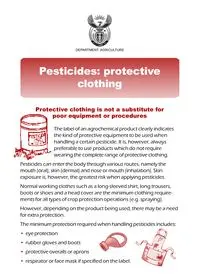
Pesticides Protective Clothing 2004 PDF
Preview Pesticides Protective Clothing 2004
1 Protective clothing is not a substitute for poor equipment or procedures DEPARTMENT: AGRICULTURE Pesticides: protective clothing The label of an agrochemical product clearly indicates the kind of protective equipment to be used when handling a certain pesticide. It is, however, always preferable to use products which do not require wearing the complete range of protective clothing. Pesticides can enter the body through various routes, namely the mouth (oral), skin (dermal) and nose or mouth (inhalation). Skin exposure is, however, the greatest risk when applying pesticides. Normal working clothes such as a long-sleeved shirt, long trousers, boots or shoes and a head cover are the minimum clothing require- ments for all types of crop protection operations (e.g. spraying). However, depending on the product being used, there may be a need for extra protection. The minimum protection required when handling pesticides includes: • eye protection • rubber gloves and boots • protective overalls or aprons • respirator or face mask if specified on the label. 2 Overalls Cotton is the most effective material for protective clothing. Overalls should preferably have elasticated (close-fitting) cuffs and no pockets. Eye and face protection A basic face mask made from clear transparent material gives comfortable eye and face protection. Face masks often give protection against splashes and are less likely to mist over than goggles. Gloves Protective gloves are available in a wide range of materials. Select gloves that fit comfortably and have a firm grip on a product container. Gloves must be long enough to at least cover the wrists and 90 mm above the wrist. Always wash gloves with soap and water before removing them from the hands. Do not touch dirty gloves with bare hands when removing them. They should be turned inside out and again be washed. Allow to dry before storing them. Boots Rubber boots give the best protection. They should at least be calf length and unlined. Trousers should be worn over the boots (on the outside) to prevent spills or splashes from 3 running down the boots on the inside. Boots must be washed inside as well as outside after use and be allowed to dry before being stored. Head coverings Head coverings are recommended as protection against spray drift. In some cases such as when applying powders, a special cap covering the head, neck and shoulders is recommended. Wash working clothes separately from other clothing. Severely con- taminated clothes must be disposed of in a safe manner. Before handling or applying any agrochemical product READ THE LABEL ON THE CONTAINER AND STRICTLY FOLLOW THE INSTRUCTIONS The WARNING and PRECAUTION sections on the label contain vital information on protection of people against these products 2002 (Revised) Compiled by Directorate Agricultural Information Services, Department of Agriculture in cooperation with AVCASA Printed and published by the Department of Agriculture and obtainable from Resource Centre, Directorate Agricultural Information Services Private Bag X144, Pretoria, 0001 South Africa This publication is available on the web: www.nda.agric.za/publications For further information contact AVCASA Tel (011) 805 2000/70/79/85 Fax (011) 805 2222 or The Registrar, Act No. 36 of 1947 Department of Agriculture Tel (012) 319 7303 Fax (012) 319 6765 AVCASA 4
